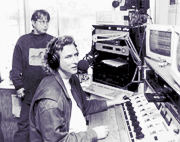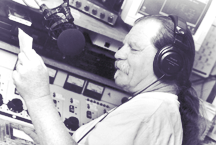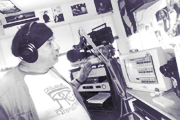Lard Almighty
Talking Heads: Disc jockey and head "cyberswine" Wild Bill Goldsmith hams it up while playing tunes, as KPIG program manager Laura Ellen looks on.
Freedom's quirky KPIG takes the sty less traveled and finally becomes--gulp--a success
By Kelly Luker
Like many fellow Santa Cruzans, I left this blissful burg for a time to search for fame, fortune and a respectable life. Periodically, I would motor up from my new digs in San Diego, watching the Southland's mini-malls and crowds eventually give way to the dry hills of Paso Robles.
"Home" began somewhere around the Brussels-sprout fields in Salinas, not with a landscape, but with a radio signal. Sometimes it called itself KFAT, sometimes KHIP and, at one disastrous turn, it passed itself off as "The Heat." With its mixture of real country, blues and folk, frequently revolting humor and enjoyably stoned DJs, the homespun radio station symbolized all that I had left behind to get ahead.
And it broke my heart when I would search the dial on some of those trips only to find dead air where once I found a heaping helping of weirdness.
But just like some of its listeners from that era, that sucker raised itself from the grave and roared back with a vengeance. Make that oinked back. Now known as KPIG, the little radio station that couldn't is flirting with success.
Found, paradoxically, at the far right of the dial--107 "Oink" Five--KPIG has managed to do the impossible. While every other music channel wedges itself into a neat confines of a profit-proven format--think classic rock, lite jazz, urban adult contemporary--the hellraisers at KFAT/KHIP/KPIG stuck around for 20-some years until they finally inspired their own distinct format: Americana, as the Gavin report dubs it.
According to Rob Bleestein, a former KHIP staffer and now Americana editor for Gavin, the radio industry's trade publication, there are presently about 80 stations patterned after KPIG's musical format. However, few if any radio stations attempt to follow in KPIG's Bozo-the-Clown footsteps. Interspersing cuts by John Hiatt, Dar Williams, the Beat Farmers and the Right Reverend Billy C. Wirtz are ads for the "Not Sold in Stores Store" or the "Hooked on Phonics Rehab Center," not to mention Speculation Theater (one skit offers a thoughtful interpretation of Dirty Harry as a John Bradshawtype psychiatrist) and commentator Travus T. Hipp, who spins the morning news and mans his Sunday talk show as only a self-styled dangerous radical can.
Bobbin' for Road Apples: KPIG DJ Buffalo Bob Cassidy has been playing tunes and raising hell around the pigsty since KFAT's heyday.
The First Piggy Purveyors
No one expected the radio station to survive this long, much less ever turn a profit--including cofounder Laura Ellen Hopper. Talking today from her comfortably messy office next to the KPIG studios in Freedom, Hopper agrees that most of the station's history has been characterized by "an amazing lack of business sense." Now program director, she has watched the station change hands from longtime owners Radio Ranch Inc. to media conglomerate Elettra Broadcasting in September of last year. At least she thinks that's her owner's name, she says, rifling through her Rolodex to be sure.
Hopper admits that everyone panicked at the thought of being gobbled up by one of the big guys, but so far Elettra has kept its hands off the pigsty. "They like us and they leave us alone," Hopper says.
Corporate headquarters certainly hasn't messed with the interior decoration at this row of offices behind the Chinese takeout joint off Main Street. As Hopper talks, her dogs Rose and Amy (also listed on her business card) wander around the pigaphernalia-strewn room. The walls of the studio have long since disappeared behind photos, articles and postcards plastered from floor to ceiling. Unlike grown-up radio stations where the studio is sequestered behind soundproof doors with warning lights when the jockey is on the air, this one rarely closes what door there is between the hall and outside world, allowing the audience an ear into whoever or whatever might be wandering through.
Born in 1974, the original KFAT was the brainchild of Hopper and then-husband Jeremy Lansman. Coming from Texas with educational radio as their background, they opened up shop at a Gilroy station that had the dubious distinction of having the lowest power signal in California. But Jeremy had a way with techie stuff and cleaned it up, boosting the signal so the little runt could be heard from San Jose to San Francisco.
The Austin scene was heating up, so the Texas couple decided it was high time to give voice to outlaw voices like Jerry Jeff Walker, John Prine and Emmylou Harris. Although it was often characterized as a country music station, KFAT and its progeny studiously avoided the treacly, packaged crap that Nashville was prone to push. It not only gave an outlet to the outsiders of the country music industry, but also to bluegrass, blues and folk musicians and, most importantly, homegrown talent like Larry Hosford and Jill Croston, now known as Lacy J. Dalton. But it was the personality--make that personalities--of the Central Coast station that most likely inspired such a devoted cult following.
Just Say High
Kfat always took the high road. As Michelle Busk, who was known behind the mike as Sister Tiny during several of the station's incarnations, says, "In the '70s, there was a lot of partying going on and KFAT was the party." She describes dogs and children running through the studios during the day, while night found bands and fans dropping by with the era's requisite offerings of blow, smoke or whatever.
Busk's fellow DJ at the time, Buffalo Bob, remembers one particular acid trip that came on right before he hit the airwaves. Unable to talk, he only laughed hysterically between songs.
Now living in Silver City, Nev., Busk remembers those times with affection. Like most of her co-hosts, she had no professional training, instead learning her chops by the seat of her pants. "I was a single mother on welfare," she remembers. "I got a call from a complete stranger asking me if I wanted to be a DJ--I thought it was a joke. But it not only became my profession, but my art outlet. I could go in there feeling really awful and heal myself with the music."
Busk probably also was healing others as she learned to "blend and mend" the tunes with each other. She recalls a phone call she got, right before she left the station for good. "Some guy called and said, 'Sister Tiny, you've been in our living room for so long, it's like you're one of our family.' It made me feel like I'd made a difference."
Bob Cassidy, under the moniker Buffalo Bob, has held down a shift off and on during the porker's various incarnations since 1975. Cassidy also hadn't a clue about radio before he was hired by KFAT and was a "regular guy," as he puts it, holding down jobs at Lone Star Cement and Salz Tannery.
Cassidy has sparse company in that regular guy self-assessment--"notorious" and "infamous" are just a few of the printable ones amongst a poll of his acquaintances. He does the "Bison Boogie" from 7pm until midnight--"I don't interface well with the office," Cassidy intones dryly. He says he's been fired more times than he can remember "for being insubordinate. And I drink on the air and get plowed." Cassidy has spent more than a few nights in the slammer for his exploits. As he puts it succinctly, "I've had a long exposure to the law."
Downing several cups of coffee as we talk one morning, Cassidy admits that age and marriage--to a lawyer, no less--have managed to slow him down some, but not by much. His graying ponytail pulled back from a face carved with years of debauchery, the grizzled raconteur is a hoot to cut it up with because he never wastes valuable time trying to edit his thoughts. Down-and-dirty stories and opinions about everyone and everything pop up continuously, including nasty asides on co-worker Travus T. Hipp ("I'm afraid he's gone around the bend"), boss Laura Ellen ("power mad") and popular--and now deceased--KFAT personality Gordy ("The biggest jerkoff that ever lived").
But they are all family to Cassidy--a weird, slightly dysfunctional family, perhaps, but family nonetheless. And that family has always extended beyond the funky walls of the studio. Cassidy remembers getting busted by the local heat while smoking dope in a motel room with a few young things. With a warrant already outstanding for a drunken-driving beef, Cassidy was off to jail. However, seeing an opportunity to make a silk purse from a sow's ear, the KPIG gang got together and staged a "Buy Back Buffalo Bob" event, encouraging listeners to phone in with enough donations to throw his bail.
"That was one of the best promotions we ever had," chuckles Cassidy. It also illuminates the camaraderie listeners feel for those voices they hear every day. It is this "real radio" that Cassidy believes listeners hunger for. In his opinion, KFAT could have been a huge success if it wasn't for the "sleazebags" in sales who, he's convinced, were trading out too many ads for cocaine.
But Cassidy smells success again on the horizon. "I'm hoping for syndication. The problem is, we're an anti-commercial air space," he explains, adding that for virtually every other station "music is a conveyance for the commercials. If [management] cut us loose, we could be the most successful format in the country."
Mo' News Is Good News: News commentator Travus T. Hipp phones in the news weekday mornings from his home in Nevada and drives down to the KPIG studios for his Sunday-morning talk show.
Pigs in Space
Travus T. Hipp has watched the progression of the hip radio industry--from his job as one of KMPX's earliest salespeople almost 30 years ago to his role today of news commentator with KPIG. Like his friend Cassidy, Hipp avoids the barber's chair, and during a visit over breakfast after his Sunday morning show, his gray hair is braided and tucked into a rather odd piece of millinery. A T-shirt emblazoned with his name and that of his company--Cabale News Service--covers an expansive girth.
Both loved and hated for his sometimes brilliant, sometimes crackpot views on current events, Hipp nonetheless wins listeners and respect with his delight in filleting both right-wing and left-wing dogma. Hipp phones in his early-morning commentaries during the week from his home (frequently from bed, according to Cassidy) around the corner from Michelle Busk in Silver City. Each Saturday, though, he gets in one of his ancient Volvos or boards a plane for the Central Coast, staying at friends' digs overnight so he can do his two-hour commentary in person the next morning.
Hipp has watched the business long enough to formulate a theory about radio stations, which he calls the IOU progression--Innovators, Operators and Undertakers. The innovators come up with the idea, the operators make it work, and finally someone who knows nothing about radio buys the station as an investment and buries it in the pursuit of turning a buck. But Hipp doesn't seem too concerned with his station's recent purchase. He guesses that it will be "years" before there's any negative effect.
The business of quirky radio--radio with personality as opposed to personality-driven radio--which Hipp entered several decades ago, died by the early '80s, having been "researched to death," according to Bill Goldsmith, KPIG's morning DJ, known to the world as Wild Bill. "We're one of about a half dozen music stations in the country that doesn't use a computer database to spit out what to play." He explains that most stations only program "carefully researched music to trick listeners into thinking they're listening to more variety than they do."
Hipp adds, "There's nothing [stations] are doing [on their own] that make people listen."
Delightful as it is today, the Pig has grown and changed from its fat predecessor. Musically, it sports more rock than before, which Cassidy likes. It also reflects the retrowomen folk singers movement which, Goldsmith admits, he could do without. Busk remembers the station starting to bow to formatting as far back as 1979 or '80, the first time it was sold.
Perhaps some of that insanity that often passed for spontaneity had to give way for survival. As the amateurs slowly grew into professionals over the years, polish replaced the rough edges, which may have also paved over part of its charm. And although a few of its staffers look like they're stuck in the '70s, the station has no intention of becoming mired in the past.
Just ask Goldsmith. Also known as "head cyberswine," Goldsmith has been responsible for herding the pig into the 21st century--and by all accounts, he's done well. Goldsmith was instrumental in creating a Web site(http://www.kpig.com) for the radio station that gives listeners Hipp's daily commentary, profiles of all the DJs and, of course, "hot links" to other sites. It was also one of the first Web sites that gave Net surfers an opportunity to listen in on KPIG anywhere in the world. Goldsmith also has wired up the studio with the "Ham Cam," which uploads videos to the Web site of the DJs working (or not), allowing listeners to be viewers as well.
Mighty cool bells and whistles, but what does it all mean in the long run? Goldsmith knows the cybersty is in the "rudimentary stages," but he's got great hopes. "In a couple of years, listening to the radio will be much more interactive," he figures.
While KPIG may now have the perfect niche for local advertisers like backhoe operators and the "Critter Gitter" (raccoon and skunk removal), the world is a big marketplace. If that can transfer into bigger success without losing what Hipp calls "an irreverence--a serious irreverence," remains to be seen. But to paraphrase the bumper sticker, the Pig may be getting on in years, but it's doing a damn good job of refusing to grow up. Here's hoping it can hang onto that attitude and still bring home the bacon.
This page was designed and created by the Boulevards team.

Robert Scheer
Robert Scheer
Robert Scheer
From the June 27-June 3, 1996 issue of Metro Santa Cruz
Copyright © 1996 Metro Publishing and Virtual Valley, Inc.
